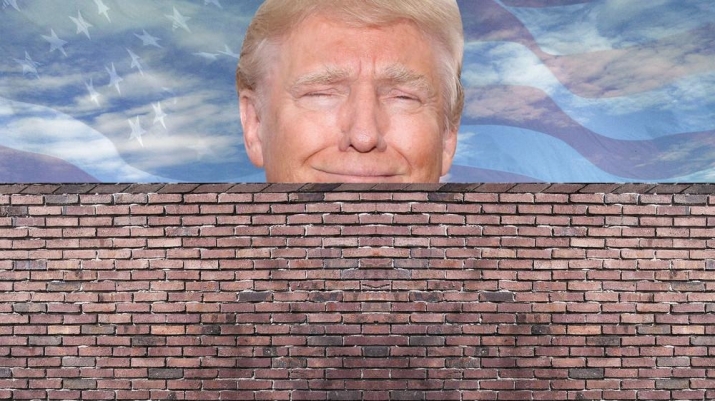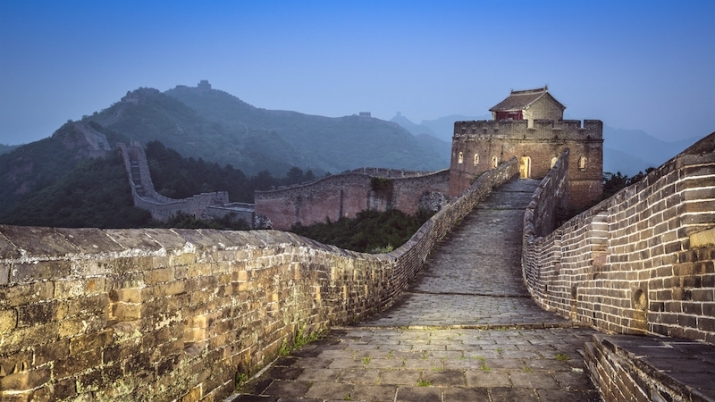FEATURES|THEMES|Commentary
Buddhistdoor View: Walls—Crossing the Boundary Between Nationalism and Imagined Communities
 From theburnward.com
From theburnward.comOne of US President Donald Trump’s most notorious pledges during his election campaign last year was to build a wall along the US border with Mexico, which was touted as a remedy for the perceived uncontrolled influx of illegal immigrants (and accompanied by a promise to have the Mexican government pay for it.) While Trump succeeded in popularizing the politics of walls in a way that has rarely been seen before, the idea of erecting walls against real or imagined enemies has long been embedded in the collective consciousness of human societies.
In these unpredictable times it is important to consider what walls mean archetypically, and to explore how societies can balance the social desire for a national identity with the recognition of this identity as an artificial construct fashioned out of national myths and narratives. This is a classic Buddhist balance between conventional and ultimate reality. We need to find a way to balance (though we rarely succeed) the desire for nationalism that ties us to our roots with the awareness that the concept of nationalism is grown from an imagined community, as political scientist Benedict Anderson (1936–2015) theorized.*
Walls occupy a complex place in human society. The imagery and narratives generated by and built around the Great Wall of China are especially complicated. While early, smaller sections of the wall were built during the reign of the first emperor of a unified China Qin Shi Huangdi (r. 247–210 BCE), it did not attain its present majestic, serpentine form until the Ming (1368–1644), a dynasty that many historians view as isolationist and protectionist. The Hongwu Emperor (r. 1368–98) proposed a ban on maritime trade in 1371. During the Qing (1644–1912), the British colonial administrator and diplomat Lord Macartney (1737–1806) admired the wall’s ambition and engineering, yet at the same time was famously derisive of, and frustrated by, the Qianlong Emperor’s (r. 1735–99) apparent reluctance to allow free trade.
 The Great Wall of China. From hostelite.com
The Great Wall of China. From hostelite.comThe European narrative of hermetic isolation coincided with the Great Wall’s construction during a time when China did not truly see itself as a nation state until the latter half of the 19th century. The Great Wall took on new meaning for Chinese nationalists as a symbol of sovereignty over and against foreign extraterritoriality and colonialism, as well as a sense of loyalty to a country and civilization that needed to be defended against both foreign aggression and internal chaos.
On the other side of Eurasia, work on Hadrian’s Wall was begun in 122 and completed by 128. The 117-kilometer barrier was meant to defend the far frontier of the Roman Empire against the antagonistic tribes of Britain’s north, however, under fatal pressure from Germanic tribes on the Continent, Rome withdrew its troops over a number of decades and by 402, its Briton subjects were on their own. A common image of the imperial power’s abandonment was the vacated wall, empty of Roman soldiers to man and maintain it. Hadrian’s Wall is a testament to the irony of empires: having conquered and expanded until it was overstretched and unsustainable, the wall was a defensive confession of imperial insecurity, an attempt by Rome to retain what was never hers to begin with.
The Berlin Wall also had its own unique symbolism and mythology. Its fall in 1989 was tied, perhaps over-simplistically, to the demise of the Soviet Union. Nevertheless, the “end” of America’s nemesis heralded political scientist Francis Fukuyama’s completely premature “end of history,” the era of open borders and globalization through Pax Americana. Could anyone have fathomed back then, in the budding age of neoliberalism, that an American president would be talking of erecting walls again? Yet, around the world, there are 70 border walls physically separating adjacent countries. Furthermore, nationalism is not only a reality; it is a resurgent one that could be seen as a direct repudiation of globalization and borderless societies.
 The Berlin Wall came down on 11 November 1989. From rt.com
The Berlin Wall came down on 11 November 1989. From rt.comThe chaos and divisiveness of Trump’s administration to date has demonstrated that walls, when understood in a shallow and materialist way, can misdirect popular anger, as one can see from the fear and suspicion directed toward Mexican illegal immigrants. Since many more illegal immigrants enter America through channels other than crossing the US-Mexico border, Trump’s wall merely serves to distract many Americans from domestic problems that can really only be solved through long-term and introspective reforms.
The examples of the Great Wall of China, the ruins of Hadrian’s Wall, and the long-demolished Berlin Wall should make it amply evident that walls are rarely effective or helpful at all. Rather, their immense influence lies in the multilayered symbolism and cultural worldviews that people project onto them. Perhaps Trump’s wall might someday offer a positive lesson when historians look back on his administration, but it is probably too early to say now.
Walls should be understood in a symbolic and archetypal way; not all boundaries are bad. When someone barges into our personal space or tries to threaten us, we rightly defend ourselves. When a bully uses racist, sexist, or other forms of harmful speech to humiliate, intimidate, and dehumanize others, we demand that it stop. When a country is attacked without provocation, most Buddhists will agree that self-defense, with a care to minimize civilian casualties, is morally justified. The Great Wall of China serves much better as a symbol of civilizational continuity and integrity than a statement of isolationism. Hadrian’s Wall is not only a beautiful tourist spot, but also a sobering warning of the inevitable fate of all empires. And the Berlin Wall’s collapse has, in some ironic way, led to Trump’s wall, with the US swinging from globalization to retreat.
 Hadrian's Wall. From hadrianswallcountry.co.uk
Hadrian's Wall. From hadrianswallcountry.co.ukIntellectually, it is easy to assert the self-less nature of all nations (and all beings, for that matter). One can even make appeals to our common humanity and shared interests to promote the wellbeing of multiple countries, and not only one’s own. However, we cannot avoid the fact that civilizations exist, nation-states are the prevalent form of political and societal organization, and borders are inherent to the existence of such states. As such, walls can be neutral, beneficial, or harmful for a given community or nation depending on how they function and are imposed. Certain social and imagined borders and walls are necessary—but not always in obvious or unambiguous ways.
* Anderson, Benedict. 1983. Imagined Communities: Reflections on the Origin and Spread of Nationalism. London: Verso.
See more
Border walls aren’t unheard of, but today they increasingly they divide friends, not enemies (LA Times)














